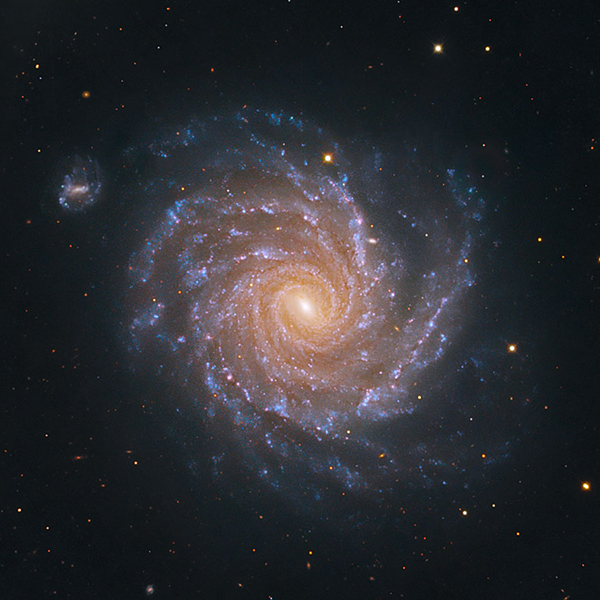NGC 1232 is a wonderful example of a spiral galaxy with a companion at the end of one arm. It is also a wonderful example of obviously discordant redshifts that have either been covered up or are simply ignored by mainstream astronomy. NGC 1232 and its companion, NGC 1232A, were first listed as Arp 41 in Dr. Halton Arp’s Atlas of Peculiar Galaxies published by Caltech in 1966. They are also discussed in Dr. Arp’s book Quasars, Redshifts and Controversies (Interstellar Media, 1987) and are mentioned in several papers published by him in The Astrophysical Journal. The following image is from the European Southern Observatory’s (ESO) 1.5m Danish telescope in Chile. I have cropped the original image in order to fit it on this page but it is otherwise unaltered.

From the color and morphology of NGC 1232A alone it is very apparent that it is a part of its parent galaxy NGC 1232. But if one traces the spiral arm to which NGC 1232A appears faintly connected back to the core of NGC 1232 a great disturbance and split in the arm is clearly visible. Perhaps, as Dr. Arp suggests, this is the path taken by the companion object after it was ejected from the core of the parent galaxy? Regardless of how the companion object reached its current location, I noticed during my research that its existence is either entirely ignored in the scientific literature describing NGC 1232 or it is described as being at the same or similar distance as NGC 1232. However a quick look at the NASA/IPAC Extragalactic Database (NED) reveals that not only does the companion object exist, based on its listed redshift it is supposedly located much, much further away.
According to its listing on NED the redshift of NGC 1232 is 0.005347 z which places it at a supposed distance of approximately 95 million light years from Earth using a so-called Hubble Constant value of 55 (km/s)/Mpc. However, NED lists the redshift of NGC 1232A as 0.022012 z which supposedly places the companion object at a much greater distance of approximately 390 million light years from Earth using a so-called Hubble Constant value of 55 (km/s)/Mpc. It is no surprise then that these numbers have been suppressed by the scientific community. Otherwise astronomers and cosmologist would have to face the fact that extragalactic redshifts do not represent distance or expansion of the universe for that matter. And if that were true where would that leave the Big Bang Theory and their jobs?

Another interesting feature of NGC 1232 is a small but bright object that appears right next to the aforementioned split and disturbance in the spiral arm leading out to NGC 1232A. Dr. Arp measured the redshift of this object at 28,000 km/s or 0.0934 z which places it at an astonishing 1.63 billion light years from Earth! It has been argued that this object is a distant background galaxy shining through NGC 1232 but there is no possible way a background object’s light could make it through the stars and dust of a galaxy’s spiral arm. Dr. Arp explains in his book Quasars, Redshifts and Controversies that even if a background object were to show through a thin area of a spiral arm its color would be deeply reddened.
There are several examples of this reddening effect visible between the arms of NGC 1232. The image on the left is a vertical slice of a larger ESO photograph showing a couple of these examples. In this image the bright high redshift object is at the top, embedded or even possibly slightly in front of the disturbed spiral arm of NGC 1232. In the middle of the image slice is a small spiral shaped object just showing through the end of a gap between the disturbed spiral arm and another large arm to the right. Notice how red the object is compared to the one at the top. Toward the bottom of the image slice is another object of the same size and morphology peeking through the edge of a small band of stars and dust between the base of the arm on the right and another arm just out of view at the very bottom of the image. This object is also the same red color as the object in the middle and both look nothing like the object at the top which is actually quite blue in comparison.
So once again we have a clear and unmistakable example of visibly associated objects that display greatly discordant redshifts thereby negating redshifts as a measure of distance and universal expansion. And yet once again the observations are completely ignored and once again I find it my duty to bring them out into the light for all to see. Eventually if enough observations are revealed their existence will no longer be able to be ignored and their implications will finally have to be faced and discussed. So as always I will keep posting to this site and thanking you for reading and encouraging everyone to pursue their own observations and to share any interesting ones!
Shannon
